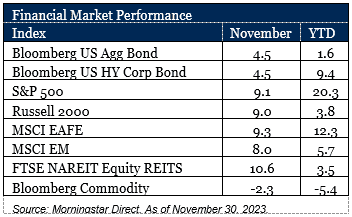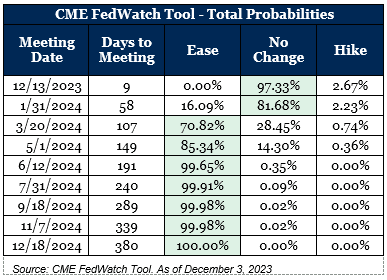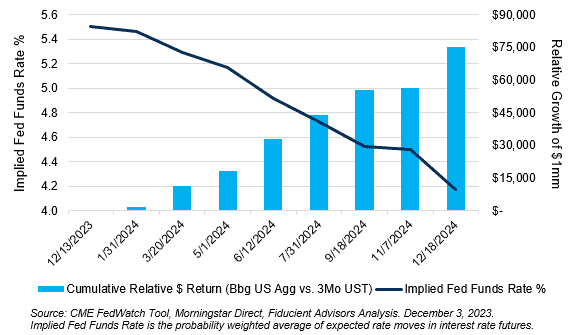Market Review
Cheerful for the Holidays
Markets rallied in November giving investors plenty for which to be thankful.
November 2023
Key Observations
- Longer dated interest rates experienced a significant decline as market sentiment leaned towards anticipating 2024 rate cuts.
- Overall, markets showed positivity, driven by heightened risk appetites fueled by the decrease in rates and a less hawkish central bank.
- Investors holding excess cash may face opportunity costs if anticipated rate cuts materialize in 2024.
Market Recap
Interest rates fell sharply durin g the month driven by moderating inflation data and a subsequent shift in the Federal Reserve’s tone towards a less hawkish stance. Global markets saw a rally with investors anticipating monetary easing. Although the U.S. yield curve exhibited a “bull flattening” trend (with the long end falling more than the short end), it remains inverted.
g the month driven by moderating inflation data and a subsequent shift in the Federal Reserve’s tone towards a less hawkish stance. Global markets saw a rally with investors anticipating monetary easing. Although the U.S. yield curve exhibited a “bull flattening” trend (with the long end falling more than the short end), it remains inverted.
Bond prices surged as rates fell across the curve and the Bloomberg U.S. Aggregate Bond Index recorded its best monthly return in 30 years. Expectations of a rate hike pause and moderating inflation alleviated pressure on rates. Notably, November marked the first month since May of this year that fixed income markets broke a streak of monthly declines. Across various fixed income sectors, returns outpaced Treasuries on a duration-adjusted basis, propelled by tightening credit spreads and an increased risk appetite amid favorable fundamentals. This trend is evident in the year-to-date returns of U.S. High Yield Corporate Bonds, which have surpassed other segments within the fixed income markets.
Global equity markets experienced a notable rebound in November. In addition to the Federal Reserve’s shift in tone and the positive economic data trends mentioned earlier, robust earnings growth in the third quarter played a crucial role in driving market momentum and revitalizing investor interest. The S&P 500 Index posted a substantial return of 9.1% for the month. The “Magnificent Seven,” comprising major technology giants Amazon, Apple, Alphabet, Meta, Microsoft, NVIDIA, and Tesla, demonstrated strong performance during the month, with all members except Alphabet (+6.9%) and Meta (+8.6%) outperforming the S&P 500 index. However, all constituents of the Magnificent Seven have delivered eye-popping returns year-to-date, ranging from +46 to +220%. Despite lagging year-to-date, small cap rose as investors continued to assess the probability of a soft landing and a Fed pause.
International markets mirrored the positive sentiment, aligning with domestic markets for the month, buoyed by U.S. Dollar weakness. China continues to weigh on emerging markets, which lagged developed markets in the month despite posting a positive absolute return. Deflationary concerns, weakness in the real estate market, an underwhelming reopening from COVID-19 restrictions, and subpar economic activity have contributed to poor sentiment for the country.
Real Estate Investment Trusts (REITs) experienced a rally in the month, aligning with the positive performance of equity counterparts and managing to enter positive territory year-to-date, despite challenges in the commercial real estate sector. The overall strength was bolstered by a declining interest rate environment, with data centers standing out as top performers, driven by a positive outlook for Artificial Intelligence (AI).
Commodities were the only asset class to struggle during the month, driven primarily by a declining energy sector. The decline in oil prices played a significant role in weakening returns, as concerns grew regarding a potential slowdown in global demand for the commodity. However, at the end of November, OPEC+ announced upcoming production cuts slated for 2024 to support prices, providing a potential positive turn for the sector.
Are You Prepared for the Final Descent?
One of the most notable moves for the month was the velocity at which rates moved lower, driven by recent data that has led to speculation that the Federal Reserve might implement rate cuts under various scenarios.
 After peaking in October, the 10-year US Treasury (“the 10-year”) fell 54 basis points throughout November, starting at 4.90% and concluding at 4.36%. This marks the largest monthly rate move in 2023, and the largest monthly decrease since 2011. Remarkably, twenty months into the Federal Reserve’s campaign against inflation, investor sentiment has shifted to believe that there is a considerably higher likelihood of the central bank cutting rates in the next four months than raising them in the foreseeable future. The market has resoundingly agreed on 2024 rate cuts.
After peaking in October, the 10-year US Treasury (“the 10-year”) fell 54 basis points throughout November, starting at 4.90% and concluding at 4.36%. This marks the largest monthly rate move in 2023, and the largest monthly decrease since 2011. Remarkably, twenty months into the Federal Reserve’s campaign against inflation, investor sentiment has shifted to believe that there is a considerably higher likelihood of the central bank cutting rates in the next four months than raising them in the foreseeable future. The market has resoundingly agreed on 2024 rate cuts.
Below is a hypothetical illustration of the potential consequences – and more acutely theoretical financial impact – of not staying invested.

Our analysis shows that there is a significant opportunity cost to holding cash over bonds should the market’s expectations be realized. Based on the implied rates from the futures market, the market is pricing in a decline of up to 133 basis points by end of 2024. Should this occur, bond math would suggest that the Bloomberg U.S. Aggregate Bond Index would return 13.3% vs. 5.7% for 3-Month Treasury Bills. To put this into perspective, if an investor had $1 million in excess cash rather than bonds, they would bear an opportunity cost of roughly $75,000 in forgone gains. This illustration underscores the significant consequences of remaining on the sidelines rather than actively participating in the bond market.
Outlook
The Federal Reserve is potentially nearing the conclusion of its hiking cycle and inflation is showing signs of moderation. On firm approved allocation, proactive adjustments are initiated to align your holdings with your long-term goals. If you have any questions, please do not hesitate to call our team at (630) 887-4404. We greatly value you and the trust you have placed in us.
Disclosures & Definitions
Comparisons to any indices referenced herein are for illustrative purposes only and are not meant to imply that actual returns or volatility will be similar to the indices. Indices cannot be invested in directly. Unmanaged index returns assume reinvestment of any and all distributions and do not reflect our fees or expenses.
The S&P 500 is a capitalization-weighted index designed to measure performance of the broad domestic economy through changes in the aggregate market value of 500 stocks representing all major industries.
Russell 2000 consists of the 2,000 smallest U.S. companies in the Russell 3000 index.
MSCI EAFE is an equity index which captures large and mid-cap representation across Developed Markets countries around the world, excluding the U.S. and Canada. The index covers approximately 85% of the free float-adjusted market capitalization in each country.
MSCI Emerging Markets captures large and mid-cap representation across Emerging Markets countries. The index covers approximately 85% of the free-float adjusted market capitalization in each country.
Bloomberg U.S. Aggregate Index covers the U.S. investment grade fixed rate bond market, with index components for government and corporate securities, mortgage pass-through securities, and asset-backed securities.
Bloomberg U.S. Corporate High Yield Index covers the universe of fixed rate, non-investment grade debt. Eurobonds and debt issues from countries designated as emerging markets (sovereign rating of Baa1/BBB+/BBB+ and below using the middle of Moody’s, S&P, and Fitch) are excluded, but Canadian and global bonds (SEC registered) of issuers in non-EMG countries are included.
FTSE NAREIT Equity REITs Index contains all Equity REITs not designed as Timber REITs or Infrastructure REITs.
Bloomberg Commodity Index is calculated on an excess return basis and reflects commodity futures price movements. The index rebalances annually weighted 2/3 by trading volume and 1/3 by world production and weight-caps are applied at the commodity, sector and group level for diversification.
Material Risks
Fixed Income securities are subject to interest rate risks, the risk of default and liquidity risk. U.S. investors exposed to non-U.S. fixed income may also be subject to currency risk and fluctuations.
Cash may be subject to the loss of principal and over longer periods of time may lose purchasing power due to inflation.
Domestic Equity can be volatile. The rise or fall in prices take place for a number of reasons including, but not limited to changes to underlying company conditions, sector or industry factors, or other macro events. These may happen quickly and unpredictably.
International Equity can be volatile. The rise or fall in prices take place for a number of reasons including, but not limited to changes to underlying company conditions, sector or industry impacts, or other macro events. These may happen quickly and unpredictably. International equity allocations may also be impact by currency and/or country specific risks which may result in lower liquidity in some markets.
Real Assets can be volatile and may include asset segments that may have greater volatility than investment in traditional equity securities. Such volatility could be influenced by a myriad of factors including, but not limited to overall market volatility, changes in interest rates, political and regulatory developments, or other exogenous events like weather or natural disaster.
Private Real Estate involves higher risk and is suitable only for sophisticated investors. Real estate assets can be volatile and may include unique risks to the asset class like leverage and/or industry, sector or geographical concentration. Declines in real estate value may take place for a number of reasons including, but are not limited to economic conditions, change in condition of the underlying property or defaults by the borrow.
All advice is offered through: MPS LORIA Financial Planners, LLC, a registered investment advisory firm. Please read all investment material carefully before any investing. It is important to consider all objectives, risks, costs and liquidity needs before investing. Please contact an investment professional for a copy of any investment’s most recent prospectus. MPS LORIA Financial Planners, LLC does not provide tax or legal advice. All information provided is for informational purposes and it is at the sole discretion of the client on how or if they proceed with any implementation of such information. As it pertains to tax or legal topics the client must discuss with their CPA or attorney before proceeding. MPS LORIA Financial Planners, LLC nor any of its affiliates, members, directors or employees can be held responsible for use of information provided. While reasonable efforts are made, information provided is not guaranteed to be accurate. This report is intended for the exclusive use of clients or prospective clients of MPS LORIA Financial Planners, LLC. Content is privileged and confidential. Dissemination or distribution is strictly prohibited.
